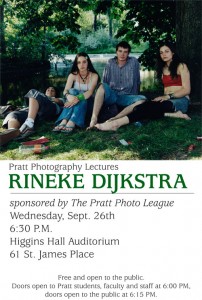RINEKE DIJKSTRA LECTURE AT PRATT INSTITUTE
Tonight I went to see Rineke Dijkstra at Pratt Institute – I was really looking forward to seeing her lecture, and having seen her retrospective at the Guggenheim a couple of months ago, I especially wanted to hear her talk about the videos included in the exhibition.
I have to admit that going to lectures is not at the top of my list – one of the last lectures I went to the “photographer” took himself so seriously, and spoke so monotonously about the details of how he created some elaborate metal sculptural frame, I was so bored I wanted to leave. He didn’t leave any mystery. I had walked in a fan of his work, and walked out disliking not only him but also the work.
Dijkstra was more interesting – the structure of the lecture was more informal – more conversational. With the Chair of the Photo department, Stephen Hilger, as the other participant, the attendees witnessed an exchange between the two. Dijkstra was very thoughtful and chose her words carefully when asked questions, but when she told anecdotes and personal stories, she was casual and at times funny. The mood was intimate and engaging. And, even though I knew some of her stories already, it was fun to hear them coming directly from her.
The lecture started off with a very brief history about her early photography days shooting for magazines and annual reports. At some point she decided to take 2 months off to figure out what her next step would be – during this time she got into a bike accident, which left her with a broken hip and 5 more months to figure out what she was going to do. Part of her therapy was to swim 30 laps, and she decided to photograph herself after the strenuous and exhaustive exercise. And this was what preempted her to make the beach series. Dijkstra was interested in photographing people when they were too tired to pose and wanted to capture a natural state. She also talked about how she doesn’t direct her subjects very much – that it’s more of an observational process.
Dijkstra also addressed technical aspects explaining that she works with a 4×5 view camera and flash. The flash was utilized mainly to keep the images looking consistent, specifically in the beach series. Because she was shooting during different times of day, the lighting would obviously be different. Using the flash created a uniformity within the series, which was shot all over the world.
The discussion then moved to New Mothers, which was a series of images Dijkstra made of mothers in Holland who had just given birth. They stood clad only in underwear, clutching their newborns close to their traumatized bodies. The images were all made at the mothers’ homes, and in the same minimal style of beach series where there was little background information. She moved furniture and set up her “studio” – just a simple white wall. Here, she also used flash, and told us how one of the babies was reacting to the flash. Worried that she was “ruining” the baby’s eyes, Dijkstra had asked the mother to cover the baby’s eyes. The baby, now 16 years old, apparently loves watching fireworks. She made 3 images for the series – the first woman was shot just an hour after giving birth, the second – a day after, the last one – a week after.
A recurring subject for Dijkstra is young people. When asked why she was so interested in them, she answered that it was because they were “less defined” and “less self-conscious.” That they were “somehow more authentic and more open.” I think this is most prominent in her videos of teenagers dancing at the Buzz Club and the Krazy House Club. For the Buzz Club, which was in Liverpool, she she set up her “studio” in the club. At first the teenagers seem uncomfortable, but the video slowly builds to an uninhibited natural state.
Finally, she presented her triple channel video of young Liverpool students describing a painting by Picasso, The Weeping Woman.
During the lecture, Dijkstra compared photography to other media, specifically painting and sculpture. She claimed that photography was the only media where you couldn’t go back and change what you made (of course, she is not considering Photoshop) like you could in painting or sculpture. She also pointed out that in photography you don’t really work alone, as in painting and sculpture where one is usually sequestered in a studio in solitude. I found these comparisons a bit odd if not irrelevant, since she didn’t really seem to consider herself as an “artist” per se, but rather a photographer. However, later during the Q&A, responding to a question, Dijkstra made some sort of allusion to having a latent desire to be a sculptor. Could you imagine Dijkstra sculpting?

